Photoshoot 1
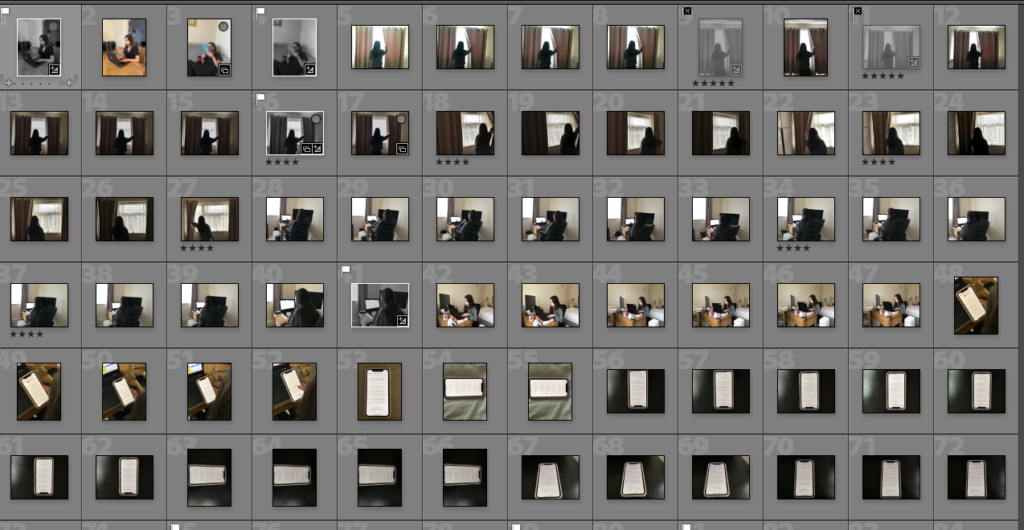
Photoshoot 2
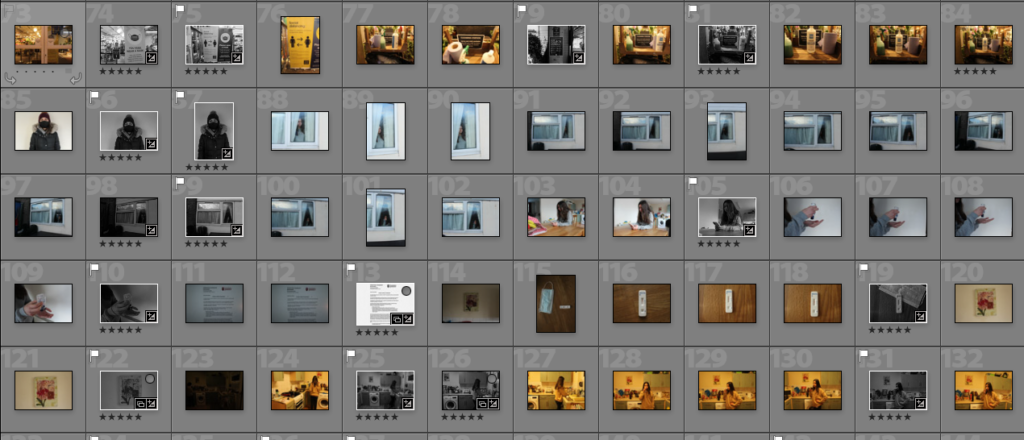
Photoshoot 3

Photoshoot 1

Photoshoot 2

Photoshoot 3

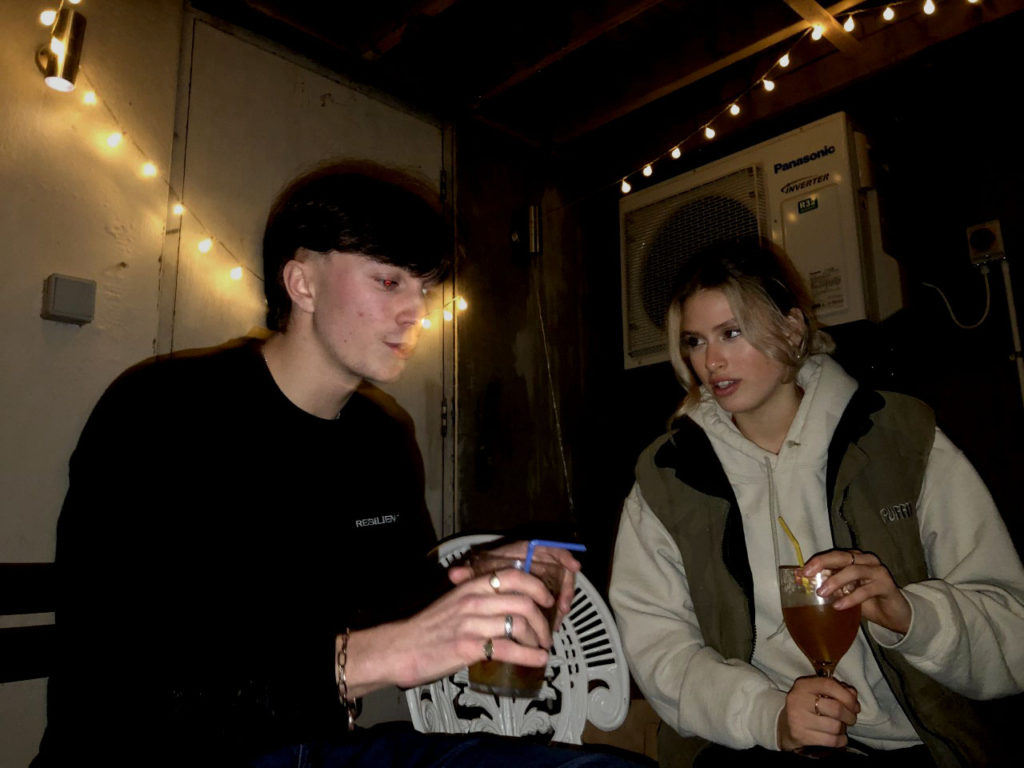
I chose to go into a nearby patch of woods that I used to walk through a lot as a child with my family, and although it was raining fairly heavily I carried on, as I thought it would help to build an atmosphere and make for interesting background noise. I had planned to take some ambient noise off the internet and use it in these parts, but my camera picked the sounds up so well I didn’t need to in the end.

I didn’t take an extraordinary amount of footage, because due to my planning I knew exactly what I needed and where it had to go in the film. I took several landscape videos, using my tripod, for the establishing shots at the beginning, then moved onto the few scenes where I was actually in the frame. These were the ending scenes from chapters one and two, and although chapter three also ends with videos me in the woods, it’s more extended than the others and I thought it would be easier to film if the weather was better, so I set it up for another time.

After selecting the correct video clips, I imported them into Lightroom and edited them slightly, only changing the vibrance to the strength I saw with my own eyes, as I know the camera tends to fade the colours a bit. This was simple as the images were all taken at the same time of day and so the lighting was all the same and I didn’t have to adjust the exposure.

Then I moved the edited clips into Premier and shortened them to the specific sections I wanted, before placing them in the right place in the chapters; because they’re both the ending scenes of the chapters I know exactly where they need to be placed.


The scene above (the end scene of chapter one) features me sitting by a tree, hearing a noise from behind and then running down the path, which is almost tunnel-like in the way it is surrounded by the trees’ branches. I used this location to represent the title of the chapter and the metaphor of a person’s mental health declining being like “going down a rabbit hole”. The main subject, me, is slightly out of focus/blurry and the natural lighting mixed with the camera exposure at the end of the “tunnel” means that the white clothes become very bright at the end. This was done on purpose to illustrate how the mind loses focus when in a state of ill health and that important things often become difficult to see clearly.
I know I still need to add a couple of landscape scenes of the outside of my house, in my room and the bathroom, as well as possibly a view of the sea to show the natural environment of Jersey, but I think the landscape clips I have already work very well and can easily be re-arranged when necessary without losing any of the atmosphere they create. I’m also very happy with the way the rain and birds and other ambient sounds were recorded by the camera and is so clear in the final footage.



In what way have Jim Goldberg and Gerard Mankowitz explored identity, rebellion and youth in their work?
INTRO
I have explored the narrative of my Dad’s music, culture and past experiences. This is done through building on the relationship with me and my Dad with our pasts and influences of our love for music. The subject of music allows me to explore themes such as race and heritage and what cultures we are a part of. It also works as a tool to explain the relationship I have with my Dad, especially as I am the photographer which grants a unique perspective. This idea is further explored through the essay “Inside Out”.
I have shown this narrative through the medium of a photobook. Within the photobook includes a variation of approaches to create a full understanding for the audience. Most importantly, I will include portraits of my Dad. The type of portraits are more tableaux and environmental meaning the subject is conscious of the camera rather than candid. This provides a more conversational feel to the book. An example of tableaux I will use is recreating an album cover for the front and back cover. Within these portraits there will be elements such as fashion and references to music and other elements of cultural significance. As well as portraits I will also include stills of objects, such as images of vinyl. In addition to vinyl I will have other objects that represent the narrative. My final medium will be text. As well as having song lyrics, I will also implement text from interviews that I’ll do with my Dad. The overall atmosphere and feel of the images will be inspired by the music which my Dad is so fond of, (………………..) thus they will be working in parallel.
For this project I am going to study Gerard Mankowitz, Jim Goldberg and significant contextual figures such as Enoch Powell. I am studying Gerard Mankowitz because he has a lot of experience on how to capture the feeling of a music genre through imagery. He also has done album covers and various other music related work such as photography for magazines. Jim Goldberg inspired me to incorporate interviews, interesting text and to photograph meaningful objects which tell a story within their own regard. Goldberg and Mankowitz also has a very close connection to exploring the theme of identity with a mix of slightly different approaches. Enoch Powell will further my project in terms of additional context, for example his “Rivers of Blood” speech. I will also study Nelson Mandela, who is another political figure. However, he has a stronger connection to my Dad’s heritage.
P1
After the second World War, the world was slowly becoming a more globalized place. All the seeds of today’s modern society as we know it were being sewn. However, tension between races were still a major problem. For example during the 50s and 60s the black population were still yet to be able to vote in America amongst many other inequalities. Similarly, In South Africa, apartheid was still in full force. This meant there was a clear separation between the white and black population. In addition the black population was at such a disadvantage within the society and barely treated as actual human beings. This is the world in which my Dad’s mum grew up in. Going to black only schools and not walking on the same side of a road in the presence of a white person. An important note is that marriage between both races were prohibited and illegal. This law greatly impacted my Dad’s mum when she met her soon to be husband from Jersey. Consequently, they had to escape the country so they could marry each other in the neighboring country *****. After this they immigrated to Jersey where my Dad would be born. From the 70s, 80s and 90s my Dad would grow up and witness the world change in relation to race, culture, and his identity. My Dad remembers seeing the news about far-right political groups like the national front in Britain, the imprisonment and election of Nelson Mandela and the abolishment of apartheid. In sense of art and culture, my Dad found himself attached to culture of Ska. Bands like the Specials were some of the first to promote a mixed race, multi-cultural message. They included both black and white members and used titles of albums like “2-tone” with black and white checked graphics. This greatly resonated with him alongside the lyrics. A prominent Specials song with powerful lyrics was “Free Nelson Mandela”. With the post-modernist movement in full effect, it gave the mass population access to this kind of thought provoking art and music. There was a clear collapse of the distinction between high culture and mass culture. In terms of music, postmodernism would be a great influence. Music would change to be non-conforming, almost the opposite of traditional and classical music. These opposing genres would be genres such as rock. No longer was there a focus on harmony and a symphony of many traditional instruments but rather a focus on performer and audience as well as an aspect of randomness. In addition to the philosophy behind music changing, the technology was as well. This progression into more affordable technology gave birth to the democratization of music. Gradually, the number of people that could now produce their own music was increasing thus giving a voice to those who did not have one before. This was especially apparent in black Britain during the time around Thatcherism and racial divides in the 60s, 70s and beyond. This is one of the major catalysts that spurred on genres like ska. This art movement inspired acts like The Specials to explore what was happening during the time through their music. Each release acted as some form of social-political commentary. This allowed my Dad to solidify his identity and where he felt he belonged through these mediums of art, music and other such as certain fashions.
:format(jpeg):mode_rgb():quality(90)/discogs-images/R-2347498-1278604125.jpeg.jpg)
Jim Goldberg’s Raised by Wolves is a great example of how identity and rebellion can be tackled photographically. The project takes a deep documentarian deep dive into the lives of runaway kids in the late 1980’s and early 1990’s. These kids and teenagers were born into to quintessential middle class suburbia in the USA. Despite being given an advantage life with opportunity, they ran away from it, from an easy life. This was possibly in a hope of finding a better life. In the generalized philosophy of the class system in America, people aspire to move up the ladder and try and achieve the so called ‘American dream’. So for these kids at such a young age, being molded to this mentality, to leave and drop down to a lifestyle with no financial security, homelessness and drug problems is quite a statement. Perhaps in the early stages they were blinded by their naivety and blissfully ignorant to the harsh outside world. However, they maintained there lifestyle, rebelling against the normality’s of society. They were so non-conforming that it became near impossible to re-conform to ‘normal’. They were a collective of true outsiders. In Goldberg’s case he was an outsider himself. He quotes “I wanted to look at those people who were outsiders, like I was”. In essence he was an outsider to the outsiders but was an outsider himself. In some convoluted form there was an apparent connection and trust they built between the two parties because of this. This translates to his final outcomes being very intimate and very confronting as there personalities are truly tapped into. This idea of whether the photographer is on the inside or outside of their subject’s circle, and whether there is a difference between the two and if so how does it effect the work. This is especially important regarding Goldberg’s work due to the fact that he needs to convey the subjects identity and their inner private lifestyle. The essay “Inside/Out” written by Abigail Solomon-Godeau explores what position and what relationship the photographer has with their subjects. An important quote from her essay reads: ”On the one hand, we frequently assume authenticity and truth to be located on the inside (the truth of the subject), and, at the same time, we routinely – culturally – locate and define objectivity (as in repertorial, journalistic or juridical objectivity) in conditions of exteriority, of noncomplication.”. This could be extended to the thought that the authentic inside truths could be mislead with bias and that the outside objective truths don’t have the whole access to every part of the truth. This translated into Jim Goldberg’s Raised by Wolves is very interesting. This is because he is somewhat part of the inside collective of youths but not completely, which means he is also an outsider to them. He gained the trust of them and spent a lot of time with the group but did not live their exact lifestyle and other factors such as the age disparity stopped him from becoming completely on the inside. In turn, this allowed Goldberg to strike a balance between both worlds of the inside and out. He was close enough to have privilege when photographing, having access to private situation and sometimes illegal activity. He also had access to photograph personal items. An example of this would be the denim jacket. This furthered access gives the audience a real peer into the lives of these runaway kids. There is a tone of sympathy and engagement throughout his work. Despite this closeness, he was never on the complete same level as his subjects and maintained his role of the photographer, for the most part. The quote: “He provided his subjects with both material assistance and friendship, and even housed Echo’s birth mother for a time when she came out west to help Echo during her pregnancy.”. This is a display of how involved he was and that the lines were blurred between him being on the outside and inside. Did this effect his objectivity, did it inject some form of bias into his work. I believe that when tackling something so intrusive and personal it is imperative for the photographer to possibly sacrifice some objectivity to achieve a comprehensive look into the subjects world. Either way, the audience will have an opinion, a bias, emotions and feeling to the work so it is near impossible for the photographer to achieve both objectivity and closeness as they are just the same human as the audience viewing the work.

Gered Mankowitz’s approach to his career is different to Goldberg’s in the sense that he has taken more of a commercial path, creating imagery for iconic rock acts from the 1960’s onwards. However, the are still some similarities between the two. Throughout Mankowitz’s various pieces of work he has had to capture the essence of who the artist(s) is. The task of capturing someone’s true identity is similar to the work of Goldberg. Not only is it the identity of the person but it is also the identity of the music they make in combination with each other. Mankowitz’s has to have both the person behind the artist and the performer at the face of the artist. Elements such as: lighting, colour or black and white, wardrobe selection, set and setting and any conceptual ideas to further the audience’s understanding of their favorite artist. In a way he is photographing two different people as the same person.
Mankowitz’s has to build a relationship to not only the artist but also the person. Over the many years of photographing the Rolling Stones, he gradually gained the trust from the group which resulted in him being able to try out more conceptual ideas. For example, his experimentation with the lens and Vaseline. He would smear the Vaseline onto the lens to create a smeared effect. This would end up creating one of his most iconic photos, the album cover of Between the Buttons. In an interview Mankowitz’s said: “Between the Buttons was a little different because by 1966 I had achieved a closeness to the band and to Andrew that allowed me the freedom to feel that I could actually contribute something to the group’s image, and in that sense, it was a concept cover.” He was finally on the inside and as a result could produce his best work. Becoming closer to the Stones, Mankowitz’s would spend whole nights in the recording studio with them, therefore educating himself in their sound before it was released. This allowed him to provide a concept that complemented the music on the album Between the Buttons. From visuals to sonics. This is where the distinction between Mankowitz’s and Goldberg lies. Mankowitz’s used his photographic techniques to translate imagery into the sound the acts were making at the time. The style of image my change based on which genre the artist represents. Is there music confronting and in your face? Then it may be best to have the subject staring directly at the camera, into the viewer’s eyes. To further analyze Between the Buttons cover, the smeared and distorted visuals of the countryside around them translates the energy they have in their music. This energy is accompanied with being at the for front of rock likewise the photo being new and experimental. When applying this thought process to Ska, there is also a similar energy. It has its times where it is lively and jumpy, but also has its songs like “Ghost Town” which provides a more dark, slow, and considered atmosphere.

My personal photographic response draws inspiration from both Goldberg and Mankowitz’s. It aims to define my Dad’s identity through the study of his cultural influences which have been molded due to his heritage and up-bringing. Within my images I have items that nod to this narrative. This was inspired by Goldberg’s approach of including images of objects that describe the subject’s identity, For example, in the image of my Dad doing the dishes, in the background there is a tin of Bos, a South African brand of rooibos tea. Also, in many of the photos he is wearing Doc Martin boots which was a staple of ska and rude boy culture. Not only is the items and clothing part of building the narrative but also the actions and poses. In the collages of my Dad dancing, they are in direct reference to the dance styles that were popular within the music he used to listen to and still does. This has been motivated by Mankowitz’s ability to link the person to the music through the imagery. The experimental nature of the blurred effect was also inspired by Mankowitz’s as it pushes the boundaries of what a photo should be in the name of trying to accomplish the feeling and essence of a particular music. Furthermore, the close relationship with my Dad gave me a head start as I already had an insight into his identity and was already confident to try out different ideas. In reference to Abigail Solomon-Godeau’s essay Inside/Out, my “engagement, participation and privileged knowledge.” Meant that my role as the photographer in the project was much more involved and apparent. My thoughts, feelings and knowledge of my Dad come through each of the images and to the extent that I appear in some of the images. In the overall composition of the photobook, there is the narrative of putting on a piece of vinyl and listening it and the experience that comes with it. Looking through the album which is playing, dancing, reminiscing and doing tasks such as the dishes. Even though this carries the viewer through the book, it is only a platform and structure to support the more conceptual side of the project being about my Dad’s identity, culture and heritage .
A key part of my film is the idea of three “chapters”: life before an eating disorder, life during it, and then the (slow) process of recovery. I chose to achieve this by making title cards, similar to those used in silent movies to indicate speech, and named them all in connection to the “Alice in Wonderland” books, which I drew inspiration from when writing the piece of text for the voiceover and used imagery from in the film itself.

I started by going into Photoshop and choosing what colour background to have for each card. In the end I went with variations of the colour blue, starting with a dark blue and ending with a pale blue for chapter three. Blue is linked to sadness and is often used metaphorically to represent depression, but it is also the colour of the sky, and so freedom, serenity and is generally considered a calming colour. I used a JPEG I found online to create to border effect similar to those in black and white movies, and once the cards were complete I saved them as singular images and put them into the film project in Premier.

Since I don’t have much actual footage at this point, I just put them in order and cut them to the length I want them on screen: just a couple seconds long enough to read the title, I didn’t want them to distract the viewer from the actual film. Because I’m using the first title card to begin the whole film, it introduces the idea of the three chapters very early on, and so the viewer isn’t surprised when these title cards appear through the rest of the film and isn’t taken out of the narrative too much.
FINISHED TITLE CARDS-


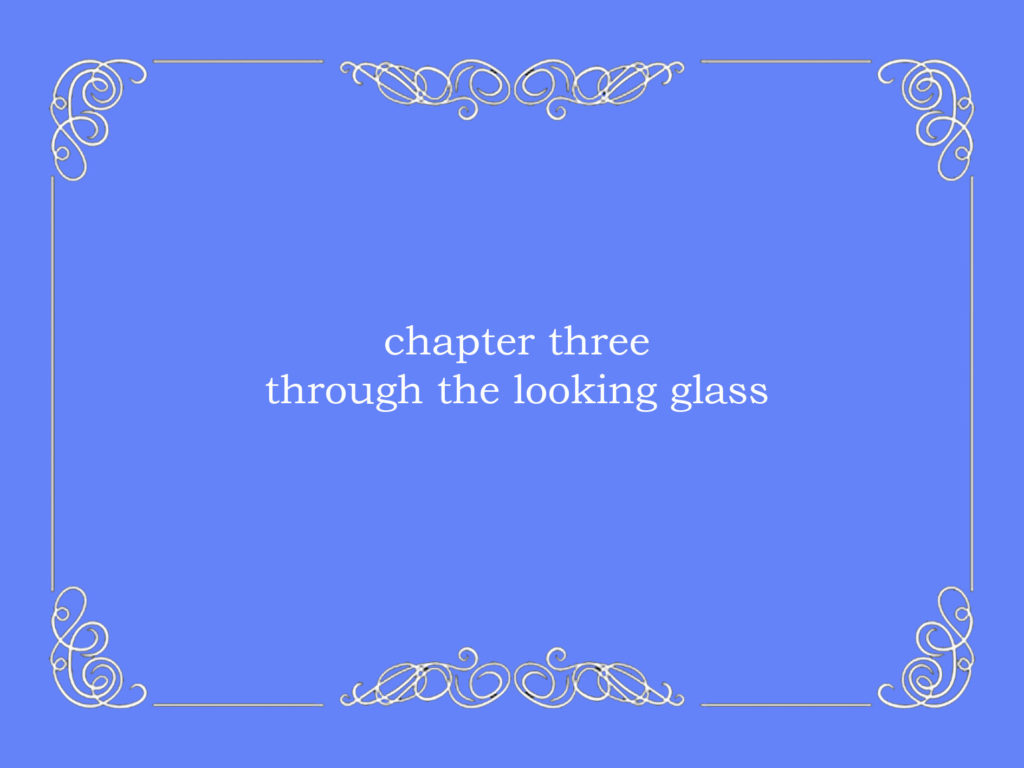
For my first shoot, I stayed at home and went through archival imagery (baby photos) with the plan to find some key ones I liked and film them for a couple seconds each, then cut them down to whatever length I decided in Premier. I used a piece of white fabric as the background to eliminate distractions and focus completely on the image in the centre. I thought about choosing only landscape images to fit better in the film, but then decided it didn’t matter so long as I actually filmed them with the camera in landscape.
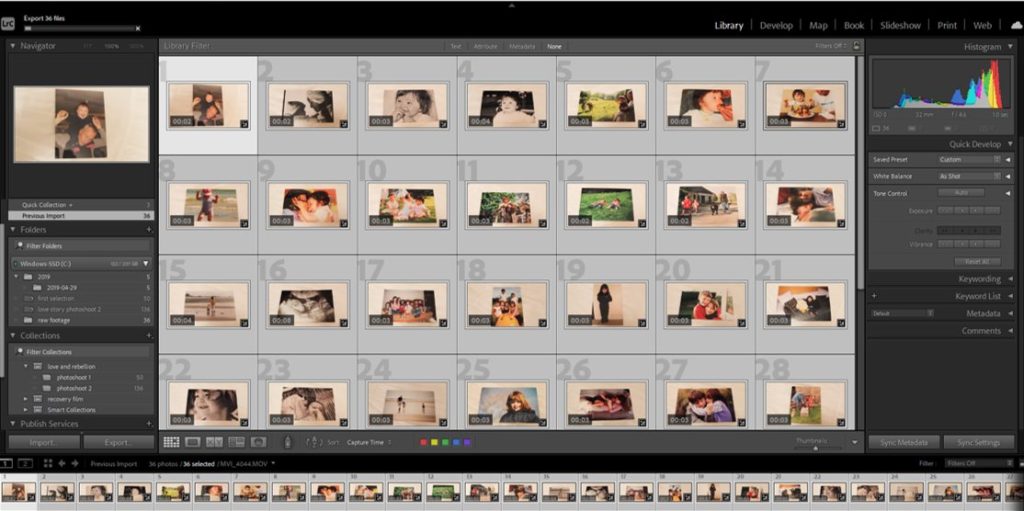
I took roughly 40 short videoclips, then imported them all into Adobe Lightroom for selection and editing before putting them into the film. Firstly I had to eliminate any that were immediately too blurry or just didn’t fit with the others in the way I expected them to, which narrowed it down to 21 clips. From there I made some minor edits, mainly increasing the exposure to hide creases in the fabric background and to make them all the same level of brightness.

After importing the images into Adobe Premier, the program I am going to be creating my film in, I played around with a few different editing ideas before settling on having five of my favourite images for 1 second and the others for half a second inbetween, simulating the concept of a flash of memories while growing up, with the core memories for longer. These included an ultrasound of me as a foetus, my first birthday, a close up of me as an infant and my mother, me with my brother and my first day in school uniform. I chose these and ordered chronologically them to represent the passing of time. It took some time to have them in an order I felt was right and to edit them all the same length of time, but my previous knowledge of how Premier works helped a lot to achieve the effect I wanted. Overall, I like the way it turned out and I feel like my selection process whittled the images down to the right length for the film, which I’m happy about.
I went through a couple of ideas for how to plan my film project and ended up using a table format to colour code the three chapters of the film and with the space to write any personal notes about audio or camera techniques.



Numbering the scenes/shots helped a lot with the soundscape part of the film, as I was able to match up specific scenes to parts of the voiceover text easily. Below is a copy of the voiceover text before I printed it out; I printed it because I find it easier to annotate it physically and visualise how it matches up to the film shots one-by-one. Printing it out also made it easier to edit any particular lines of words if I had to.


There is a reoccurring theme of “Alice in Wonderland/Alice Through the Looking Glass”-type imagery and metaphors throughout both the voiceover and in the film itself. This is because, as a child, those books were some of my favourites and I read them again and again, and still sometimes re-read them now. I found that the idea of following a talking white rabbit down into a world where nothing makes sense but is all just accepted as fact and “the way things are”, as well as the idea of going through a “looking-glass” (aka a mirror) into a world where everything is equally as utterly incomprehensible relates a lot to going through an eating disorder. ED’s are often incomprehensible to people who haven’t experienced them, and the little rituals and routines that you fall into when suffering form and ED can feel like complete nonsense once you get healthy again, like restrictions on certain foods and other diet habits. Additionally, the idea of falling down a rabbit hole and not being able to get out is applicable not only to suffering form an eating disorder, but any mental health struggle in general. Often EDs are developed by people suffering from other mental health disorders or those who are in a difficult personal situation, so the metaphor can be applied to many other situations other than simply teenage eating disorders. I made sure to only write enough to make up the allotted 5 minutes of screen time, and although it was quite difficult to write due to the personal and painful nature of the topic, I am happy with the finished outcome.
In What Way Have Richard Billingham and Matthew Finn Photographed People Who Are Close To Them?
Opening quote: “An inside position allows engagement, participation and privileged knowledge.” (Abigail-Solomon Godeau: Inside/Out)
Essay question: In What Way Have Richard Billingham and Matthew Finn Photographed People Who Are Close to Them?
Introduction (250-500 words): What is your area study? Which artists will you be analysing and why? How will you be responding to their work and essay question? For my introduction I will describe what my area of study is – film-making/documentary photography and describe what my personal project is about overall and my aim. I will then state my two artists (Richard Billingham and Matthew Finn) and give an overall description of what their work is about. This will allow the reader the reader to fully understand who I am talking about and why they are specifically relevant to my work.
Paragraph 1 (500 words): Historical/ theoretical context within art, photography and visual culture relevant to your area of study. Make links to art movements/ isms and some of the methods employed by critics and historian. Here, although I have studied Post-Impressionism as my ‘ism’, I will be referring to Abigail-Solomon Godeau. She looks at the inside/outside perspective when it comes to photography . I feel as though this is more relevant to my body of work as opposed to post-impressionism, however this will be mentioned somewhere. I’ll be doing an overall description of what she talks about in her own essay and also include Harvard Referencing in order to boost the potential marks I could get. I’ll also describe Diane Arbus and include an image of her work in order to give a fuller description of the topic, inside/outside. She was criticised for her ‘outsider’ work and accused of objectifying the people that she photographed.
Paragraph 2 (500 words): Analyse first artist/photographer in relation to your essay question. Present and evaluate your own images and responses. The first photographer I will go into analysing is Richard Billingham. I may quickly go over what he does as a photographer and then go in to analyse one of his images (and include an image that he took for illustration). I’ll then go into analysing his perspective when it comes to photographing/film making (which is an insiders perspective). Additionally, I want to go into a second opinion, for example, I could say that he uses his photography for positive effect however his images/photographs aren’t exactly positive and may be objectifying in some sense. Also, I need to include different quotes that back up my argument for Billingham coming from an ‘inside’ perspective, thus, I need to look at specific interviews.
Paragraph 3 (500 words): Analyse second artist/photographer in relation to your essay question. Present and evaluate your own images and responses. Secondly, I will look into Matthew Finn. As before, I will quickly re-describe his area of work and what he does. And then I will reflect on his in side perspective. Again, I will also use quotes to back up my ideas. I will also add in one of his images to add illustration.
Conclusion (500 words): Draw parallels, explore differences/ similarities between artists/photographers and that of your own work that you have produced. In my conclusion I will compare the two artist’s in their methods. For example, Matthew Finn takes a softer approach to his work while on the other hand, Richard Billingham is much more upfront and raw within his work. I also want to link their work with my own and suggest ways they have inspired me in my own techniques. For example, I thoroughly enjoy Richard Billingham’s, up close and personal filming and Matthew Finn’s soft, admirable approach.
In What Way Have Richard Billingham and Matthew Finn Photographed People Who Are Close To Them?
“An inside position allows engagement, participation and privileged knowledge.” (Abigail-Solomon Godeau: Inside/Out)
In this essay I will be evaluating the different ways as to how Richard Billingham and Matthew Finn have photographed/filmed people that are close to them, in this case, their parents. My area of study in my personal project is documentary photography. This is a style of photography that provides a straightforward and accurate representation of people, places, objects and events. Specifically, I am looking into filmmaking, taking a documentary approach to it. I am surrounding it around my Mum, particularly, creating a documentary film in order to expose the struggles and complications that she faces on a day-to-day basis while struggling with a terminal illness – Stage 4 Emphysema. My overall aim of my project is to create a hard-hitting film that triggers hard hitting emotions for the viewer. Since I am also filming someone who is close to me, I feel as though looking into Billingham’s and Finn’s methods will add greater knowledge to my personal work and allow me to potentially take notes from the methods they have used when photographing their own parents. Billingham started off by taking images of his parents (with no prior experience) for reference so that he could paint them, as his main aim before photography was painting. His images of his parents then got noticed and became a huge success. The images exposed his tough life living in a tower block with his alcoholic Dad, Ray, and his overweight, temperamental Mum, Liz. The exposure of his parents was intriguing to viewers and he eventually led on to create several documentary style films surrounding his parents. Matthew Finn, for over thirty years, took images of his Mother. His father did not live with him and he stated that his first intentions were not to create an archive of his Mother, but to create stability, the photographing eventually became a habit. The more Finn discovered about his father, the more he wanted to protect his Mum and be the person/man that would never let her down. The fact that his Mother was wanted and needed to be in his photography, formed a strong bond between the two and she played a huge role in the taking of the photographs. Years later, she developed dementia, and could no longer recognise Finn or herself even, thus, all he had left were these archival images.
https://www.nationalgeographic.com/photography/photo-tips/portrait-photography-tips/
https://www.theguardian.com/film/2019/feb/23/richard-billingham-ray-and-liz-interview
“I don’t think he took any notice,” Billingham says. “Or if he did it was probably that he was pleased I was in the room with him. The camera acted as a mediator.” – Richard Billingham
https://saatchigallery.com/artist/richard_billingham
https://photoworks.org.uk/richard-billingham/
https://www.getty.edu/publications/resources/virtuallibrary/0892363223.pdf
https://www.mattfinn.com/mother
https://www.photopedagogy.com/insideout.html
https://www.photopedagogy.com/uploads/5/0/0/9/50097419/week_5_abigail_solomon-godeau_inside_out.pdf
https://www.theguardian.com/artanddesign/2011/jul/26/diane-arbus-photography-sideshow
Final Deadline for improving Coursework:
MON 22 MARCH – Whole School!
Examination dates: 15 hrs controlled test over 3 days
Groups 13A and Group 13B: 4, 6 and 12 May
Group 13C: 5, 13 and 14 May
The Themes:
‘TRANSITION’ and/or ‘FREEDOMS and/or LIMITATIONS’
PLANNER
ASSESSMENT OBJECTIVES
AO1 Develop ideas through sustained and focused investigations informed by contextual and other sources, demonstrating analytical and critical understanding
AO2 Explore and select appropriate resources, media, materials, techniques and processes, reviewing and refining ideas as work develops
AO3 Record ideas, observations and insights relevant to intentions, reflecting critically on work and progress
AO4 Present a personal and meaningful response that realises intentions and, where appropriate, makes connections between visual and other elements.
Definition in dictionary:
TRANSITION
noun
1. the process or a period of changing from one state or condition to another.”students in transition from one programme to another”
verb
2. undergo or cause to undergo a process or period of transition.”he transitioned into filmmaking easily”
FREEDOMS
noun
1. the power or right to act, speak, or think as one wants.”we do have some freedom of choice”
2. the state of not being imprisoned or enslaved.”the shark thrashed its way to freedom”
LIMITATIONS
1. a limiting rule or circumstance; a restriction.”severe limitations on water use”
2. (LAW) a legally specified period beyond which an action may be defeated or a property right does not continue.
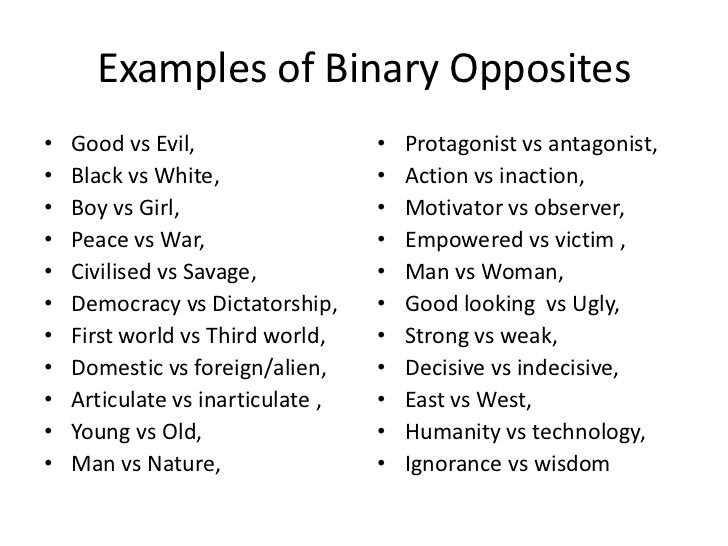
How to start – TASKS FOR H-TERM
2018 presentation with examples of Artists References from page 5 of exam booklet – showing evolution of artistic freedom
Each week you are required to make a photographic response (still-images and/or moving image) that relates to the research and work that you explored in that week. Sustained investigations means taking a lot of time and effort to produce the best you can possibly do – reviewing, modifying and refining your idea and taking more pictures to build up a strong body of work with a clear sense of purpose and direction
Preparatory Supporting Studies (Blog posts)
6 weeks of lessons + 2 weeks Easter Break:
Prior to the timed examination you must produce and submit preparatory supporting studies which show why and how the supervised and timed work takes the form it does. You must produce a number of blog posts 25-40 that charts the development of your final piece from conception to completion and must show evidence of:
Controlled Exam 15 hrs over three days: (Final Outcome)
This time is for you to fine tune and adjust your final images for print using creative tools in Lightroom/Photoshop and/or complete a final edit of your photobook, film or video in Premiere. Your final outcome(s) must be presented in a thoughtful, careful and professional manner demonstrating skills in presenting work in either window mounts, picture frames, foam-board, and/ or submit pdf of photobook, or embed (from Youtube upload) moving image and video based production to the blog.
Week 24: 8 – 14 March:
EXPLORE THEMES > RESEARCH > ANALYSE > PLAN > RECORD > EXPERIMENT > PRESENT
Lesson 1 (Mon): Seminar
Read both exam papers and discuss in class.
Homework: Photo-game 1
What to Photograph?
Deadline: One week > 15 March
Produce blog post with a selection of edited images and an evaluation
Each student think of an instruction, an object, place, or scenario to be photographed. All the instructions will be collated and given to all students in the class. Every student have to make one image of each instruction. As an example, here is a list of instructions (don’t copy!)
A red ball
A tree and a dog
An ugly photograph
A political argument
A kiss
A shallow focus image of a bar of soap
a random photograph
An unambiguous photograph
Grass and concrete
An old-fashioned photograph
A futuristic photograph
a blue car and a white car
Nigeria
Timeless beauty
Flowing water
Lesson 2 (Tue): Group work
Research 1: Analyse and interpret chosen theme(s) and produce mindmap & moodboard.
Publish on blog.
Lesson 3: (Wed): Group work
Present your research and interpretation of exam theme(s).
3 mins.
Lesson 4: (Thurs) Individual work
Statement of Intent: Based on you mindmap and moodboard begin to formulate a specification with details of 2-3 ideas that you wish to explore: How, who, when, where and why? Plan a photo shoot and/or photographic response to one of your initial ideas.
Lesson 5: (Fri) Individual work
Research 2: Begin to support your initial ideas by looking at the work of others and find inspiration from photographers listed on pages 24-27 in the Exam papers. Look also for specific starting points in other disciplines, such as Fine Art, Graphic Communication and Textile Design.
Analyse the work of at least two or more photographers/ artists with references to texts/ sources/ quotes and explain why you have chosen them and how it relates to your idea and the exam theme.
Produce quality blog posts for each artist reference that illustrate your thinking and understanding using pictures and annotation.
Plan a photo shoot and/or photographic response.
Deadline: One week > Fri 19 March
Produce blog post with a selection of edited images and an evaluation.
See blog post: DEVELOPING YOUR IDEAS: ARTISTS REFERENCES for more inspirations and guidelines on how to research and analyse the work of others.
Photogame 1: What to Photograph?
Class 13A
Class 13B
Class 13C:
Week 25: 15– 22 March:
EXPLORE THEMES > RESEARCH > ANALYSE > PLAN > RECORD > EXPERIMENT > PRESENT
Lesson 1: (Mon 15 March)
Photogame 1: What to Photograph?
Upload all images in a folder and print a set of small prints (9x13cm = 4 per A4 sheet). Lay all images in a huge grid on the tables so that vertically you can see every students response to the same instruction, while horizontally you will be able to discern each student’s approach or style.
Lesson 3 (Wed 15 March)
PHOTO-GAME 2: Photo-dice (Zen for Photography)
An artwork which consists of 5 dice, each describing a decision leading to a photograph.
Participants: Whole class, each student roll the dice once.
Aim: Roll the five dices and write down instructions
Method: Produce a set of 10 images using the instructions
Location: Outside/ Inside
Evidence: Produce blog post with a selection of edited images and an evaluation
Deadline: One week > 22 March



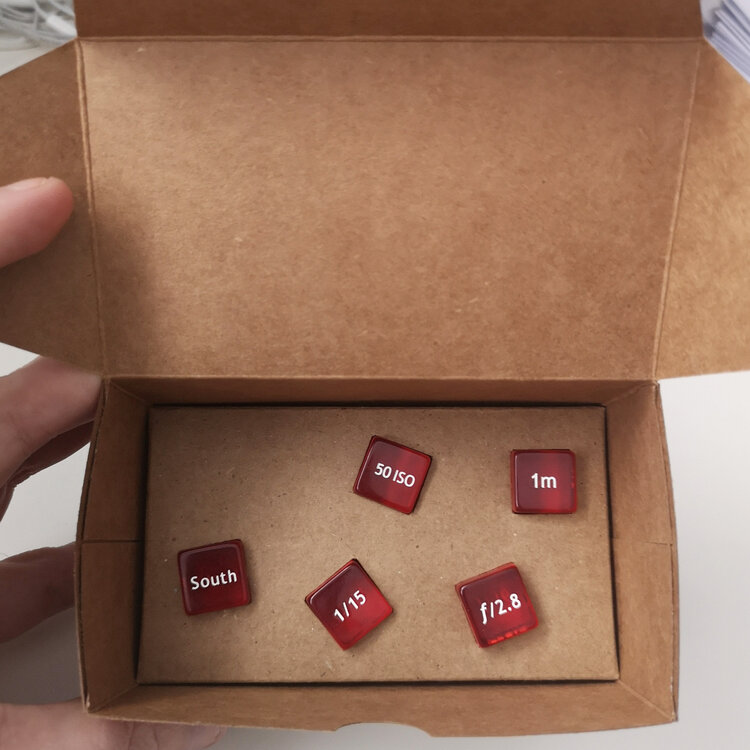


Here is a link to a new blog post with more Photogames – use it as an inspiration for generating ideas and make images. It has instructions about how to develop your own Photogame.
Produce blog post from the above photogame with a selection of images, experimentation and analysis. Make contextual links with John Baldessari work where appropriate.
Week 26-27: 22 March – 1 April + EASTER:
EXPLORE THEMES > RESEARCH > ANALYSE > PLAN > RECORD > EXPERIMENT > PRESENT
Statement of Intent
Based on you mindmap and moodboard begin to formulate a specification with details of 2-3 ideas that you wish to explore: How, who, when, where and why? Plan a photo shoot and/or photographic response to one of your initial ideas.
Research 2: ARTISTS REFERENCES
Begin to support your initial ideas by looking at the work of others and find inspiration from photographers listed on pages 24-27 in the Exam papers. Look also for specific starting points in other disciplines, such as Fine Art, Graphic Communication and Textile Design.
See more artists references and guidance here
Planning: PHOTOSHOOT
Plan at least 4-5 photoshoot you can complete by the time you return from Easter. They need to have a sense of purpose and include what, where, when, who and explain how they explore the theme. Make sure you produce at least one shoot before Easter to test out ideas and discuss with your teacher.
EASTER > Recording: PHOTOSHOOOTS
Make sure you complete most of your planned shoots over Easter break. From each shoot select 8-12 images for further experimentation. Produce quality blog posts from each shoot and analyse and evaluate your photos through annotation showing understanding of visual language using specialist terminology. Follow process below of three EEEs.
Before you break off for Easter to must have completed all the above with relevant blog posts charting your thinking and creative progress. Make sure you produce quality blog posts that illustrate your thinking and understanding using pictures and annotation.
Week 28-29: 19 – 30 April:
EXPLORE THEMES > EDIT > EXPERIMENT > EVALUATE
EXAM BEGINS TUE 4 MAY (AFTER BANK HOLIDAY)
You are expected to show evidence of the following three EEEs on the blog.
EDITING: For each shoot you have made select and adjust your best set of images using either Lightroom / Photoshop using basic tools such as cropping, exposure, contrast, tonality, colour balance, monochrome etc.
EXPERIMENTING: Make sure you demonstrate creativity and produce at least 3 different variations of the same image, eg. colour/ monochrome, montage/ grid, juxtaposition/ sequence etc.
EVALUATING: Compare your images and photographic experiments and provide some analysis of artists references that has inspired your ideas and shoots. Use the Photo-Literacy matrix below. Consider what you need to do next to develop your project? What’s your next step!
REVIEW > REFLECT > REFINE

FINAL OUTCOME
Begin to consider how you wish to present your work:
A set of final prints – single, diptych, triptych, multiple images mounted on foamboard, mountboard
A photobook – design in Lightroom using Blurb
A film – editing in Premiere